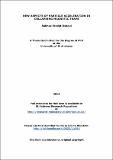Files in this item
New aspects of particle acceleration in collapsing magnetic traps
Item metadata
| dc.contributor.advisor | Neukirch, Thomas | |
| dc.contributor.author | Eradat Oskoui, Solmaz | |
| dc.coverage.spatial | 192 p. | en_US |
| dc.date.accessioned | 2017-10-30T16:38:21Z | |
| dc.date.available | 2017-10-30T16:38:21Z | |
| dc.date.issued | 2014-01 | |
| dc.identifier.uri | https://hdl.handle.net/10023/11954 | |
| dc.description.abstract | Collapsing magnetic traps (CMTs) have been suggested as one of the mechanisms that could contribute to particle energisation in solar flares. The basic idea behind CMTs is that charged particles will be trapped on the magnetic field lines below the reconnection region of a flare. This thesis discusses a number of important new aspects in particle energisation processes in CMTs, based on the model by Giuliani et al. (2005). In particular, we extend previous studies of particle acceleration in this CMT model to the relativistic regime and compare our results obtained using relativistic guiding centre theory with results obtained using the non-relativistic guiding centre theory. The similarities and differences found are discussed. We then present a detailed study of the question, what leads to the trapping or escape of particle orbits from CMTs. The answer to this question is investigated by using results from the non-relativistic orbit calculations with guiding centre theory and a number of simple models for particle energy gain in CMTs. We find that there is a critical pitch angle dividing trapped particle orbits from the escaping particle orbits and that this critical pitch angle does not coincide with the initial loss cone angle. Furthermore, we also present a calculation of the time evolution of an anisotropic pressure tensor and of the plasma density under the assumptions that they evolve in line with our kinematic MHD CMT model and that the pressure tensor satisfies the double-adiabatic Chew-Goldburger-Low (CGL) theory. Finally, we make a first step to introduce Coulomb scattering by a Maxwellian background plasma into our guiding centre equations by changing them into a set of stochastic differential equations. We study the influence of a static background plasma onto selected particle orbits by pitch angle scattering and energy losses, and look at its effect on the particle energy and the trapping conditions. | en_US |
| dc.language.iso | en | en_US |
| dc.publisher | University of St Andrews | |
| dc.subject.lcc | QB526.F6E82 | |
| dc.subject.lcsh | Magnetic traps | en |
| dc.subject.lcsh | Solar flares | en |
| dc.subject.lcsh | Particle acceleration | en |
| dc.title | New aspects of particle acceleration in collapsing magnetic traps | en_US |
| dc.type | Thesis | en_US |
| dc.type.qualificationlevel | Doctoral | en_US |
| dc.type.qualificationname | PhD Doctor of Philosophy | en_US |
| dc.publisher.institution | The University of St Andrews | en_US |
This item appears in the following Collection(s)
Items in the St Andrews Research Repository are protected by copyright, with all rights reserved, unless otherwise indicated.

